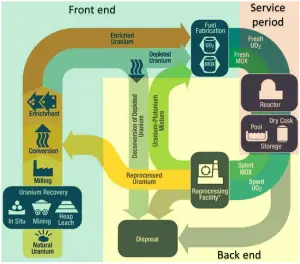
As was written, the back end of the nuclear fuel cycle involves managing the spent fuel after irradiation. Therefore, the back end of the fuel cycle consists of:
- spent fuel interim storage
- fuel reprocessing,
- final disposal of radioactive waste, or spent fuel.
There are three main types of nuclear fuel cycle:
- Once-through fuel cycle. An open fuel cycle is not a real cycle, and this strategy assumes that the fuel is used once and sent to long-term storage without further reprocessing. If spent fuel is not reprocessed, the fuel cycle is referred to as an open fuel cycle or a once-through fuel cycle, as the uranium components go through the reactor once. The once-through cycle comprises two main back-end stages:
- interim storage
- final disposal.
- Twice-through fuel cycle. The twice-through cycle strategy assumes that the spent nuclear fuel will be reprocessed to extract the uranium and plutonium, which can be recycled as fresh nuclear fuel for use in a nuclear reactor adapted to this type of fuel.
- Closed fuel cycle. The closed fuel cycle is an advanced fuel cycle whose purpose is to achieve nuclear power sustainability by further reducing the final waste’s radiotoxicity and improving resource utilization while maintaining its economic viability. There are currently different types of advanced fuel cycles under research, but most of them are based on the use of:
- Advanced Nuclear Reactors
- Fuel Reprocessing
These fuel strategies are based on specific processes in the entire fuel cycle (the back end, the front end, and the service period). All these scenarios are theoretical, and the practical solution will be, in any case, a combination of these options. In all cases, the fuel assemblies are first after irradiation, stored in spent fuel pools at the reactor site for an initial cooling period. Over time, as the spent fuel is stored in the pool, it becomes cooler as the radioactivity decays away. After several years (> 5 years), decay heat decreases under specified limits so that spent fuel may be reprocessed or interim storage. It must be added that any strategy for managing spent nuclear fuel will be built around combinations of many options, and all strategies must ultimately include permanent geological disposal.
The choices of nuclear fuel cycle (open, closed, or partially closed through limited spent fuel recycling) depend upon the technologies we develop and societal weighting of goals (safety, economics, waste management, and nonproliferation). Once choices are made, they will have major and long-term impacts on nuclear power development. Today we do not have sufficient knowledge to make informed choices for the best cycles and associated technologies.
See more: The Future of the Nuclear Fuel Cycle. An interdisciplinary MIT study. MIT, 2011. ISBN 978-0-9828008-4-3.